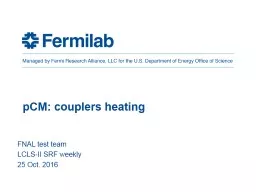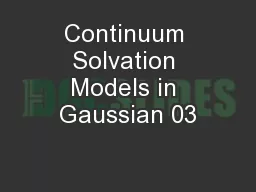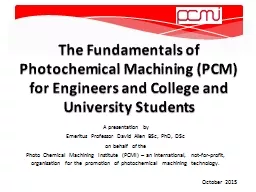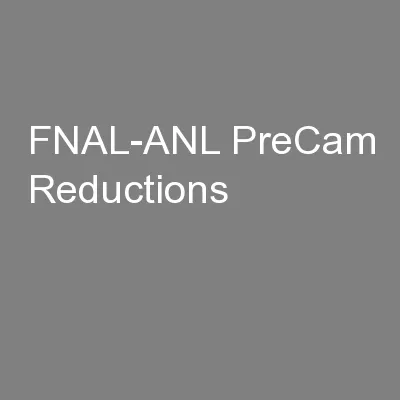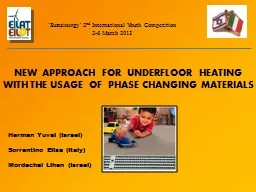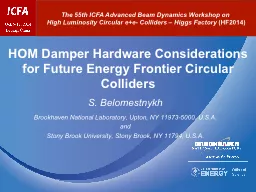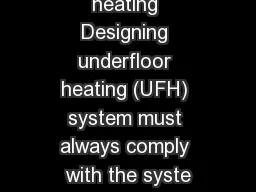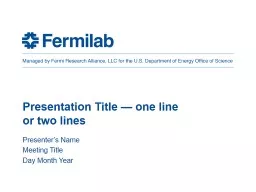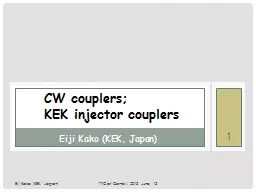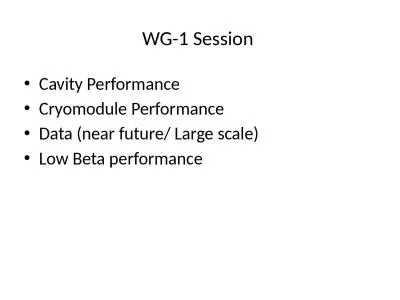PPT-pCM : couplers heating FNAL
Author : debby-jeon | Published Date : 2018-11-09
test team LCLSII SRF weekly 25 Oct 2016 Coupler diagnostics 10312016 Presenter Presentation Title 2 HTS pCM Cernox 5K 8 PT100 at CF100 16 RTD on WG IR warm ceram
Presentation Embed Code
Download Presentation
Download Presentation The PPT/PDF document "pCM : couplers heating FNAL" is the property of its rightful owner. Permission is granted to download and print the materials on this website for personal, non-commercial use only, and to display it on your personal computer provided you do not modify the materials and that you retain all copyright notices contained in the materials. By downloading content from our website, you accept the terms of this agreement.
pCM : couplers heating FNAL: Transcript
test team LCLSII SRF weekly 25 Oct 2016 Coupler diagnostics 10312016 Presenter Presentation Title 2 HTS pCM Cernox 5K 8 PT100 at CF100 16 RTD on WG IR warm ceram 8. Comfort is hard to define and is best understood as the absence of discomfort. Perhaps the most remarkable thing about radiant heat is what you won't notice. There are no forced air registers to see. No noise or dust from mechanical blowers. No hot air blowing on you. No hot air collecting at the ceiling, wasting energy. No cold floors to chill your feet. The mild warmth of a radiant floor is a subtle experience and always feels just right. Comfort is hard to define and is best understood as the absence of discomfort. Perhaps the most remarkable thing about radiant heat is what you won't notice. There are no forced air registers to see. No noise or dust from mechanical blowers. No hot air blowing on you. No hot air collecting at the ceiling, wasting energy. No cold floors to chill your feet. The mild warmth of a radiant floor is a subtle experience and always feels just right. Dr. Ivan Rostov. Australian National University,. Canberra. E-mail: Ivan.Rostov@anu.edu.au. Outline. Types . of . solvent effects and solvent models. Overview of solvation continuum models a. vailable in Gaussian. Michael Pekeler. RI Research Instruments GmbH. Friedrich-Ebert-Str. 1. 51429 . Bergisch. . Gladbach. Germany . Advanced Technology Equipment and Turn-Key System Supplier for Research, Industry and Medical worldwide. A presentation by . Emeritus Professor David Allen BSc, PhD, DSc. on behalf of the . Photo Chemical Machining Institute (PCMI) – an international, not-for-profit, organisation for the promotion of photochemical machining technology.. Douglas . L. . Tucker. (. FNAL). DES Collaboration Meeting. ICG, Portsmouth. PreCam Parallel . Session. 29 June 2011. Data Processing. DES. -. Brazil Effort. The official data processing.. Uses a PreCam-specific version of the Quick Reduce Pipeline.. H. erman Yu. val (Israel). Sorrentino. Elisa (Italy). Mordechai. . Lihen. (Israel. ). ‘Sustainergy’ 2. nd. International Youth Competition. 2-6 March 2013. Why improve energy consumption in buildings ?. S. . Belomestnykh. Brookhaven . National Laboratory, Upton, NY 11973-5000, U.S.A. .. and. Stony . Brook University, Stony Brook, NY 11794, U.S.A.. The 55th ICFA Advanced Beam Dynamics Workshop on . High Luminosity Circular . Mrutyunjay. Overview. SSD: Solid State Driver. PCM: Phase Change Memory (NVRAM: Non Volatile RAM). Comparison: SSD vs PCM. Others: . Spin-transfer . torque (SSTRAM), Magneto resistive . random-access memory (MRAM). Method used to encode information in terms of signal transition. The original binary information is recovered simply by comparing the polarity of adjacent binary symbols to establish whether or not a transition has occured. Underfloor. . heating. . advantages. :. No . need for separate heat emitter visible on the . walls. Heat . distribution is well suited to geothermal and solar thermal systems, . because . required circulating water temperature is low due . JLAB, January 11-13, 2017. Nikolay Solyak (on behalf LCLS-II team). Nikolay Solyak (on behalf . of LCLS-II . team). Coupler Performance . at FNAL . pCM. Outline. Power requirements. Coupler diagnostics in . Eiji Kako (KEK, Japan) TTC at Cornell, 2013 June 13 1 CW couplers; KEK i njector couplers Eiji Kako (KEK, Japan) Eiji Kako (KEK, Japan) TTC at Cornell, 2013 June 13 2 OUTLINE compact-ERL injector Cryomodule Performance. Data (near future/ Large scale). Low Beta performance. WG1-Session1 Cavity Performance. Camille Ginsburg (FNAL), John . Mammosser. (JLAB). Five talks were presented covering recent cavity vertical test RF performance from:.
Download Document
Here is the link to download the presentation.
"pCM : couplers heating FNAL"The content belongs to its owner. You may download and print it for personal use, without modification, and keep all copyright notices. By downloading, you agree to these terms.
Related Documents

